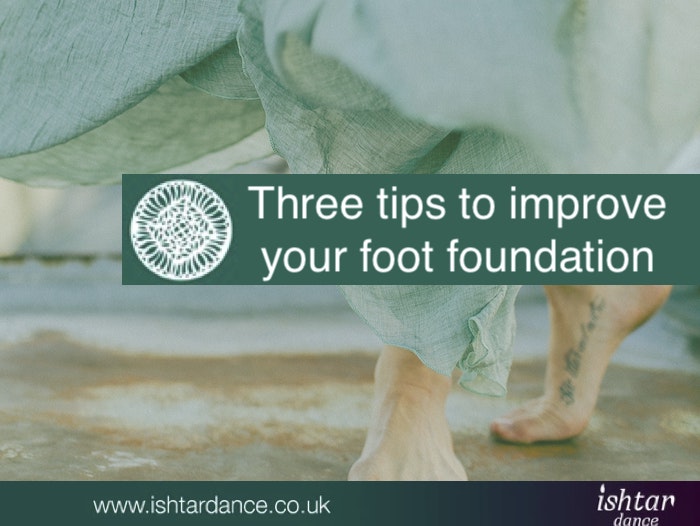Three tips to improve your dancing feet
By Ishtar Dance on Monday, July, 30th, 2018 in Dance Coaching, Dance Inspiration, Learning, Your Dance Body 2 Comments

As a dancer your feet are one of your most valuable assets, yet many seem to forget that they are the foundation on which all your movement happen. You can work on your moves, technique and stage performance for as long as you like, but it’s not until you’ve got your feet sorted, that you’re likely to see the improvement and development in your dancing that you’re after.
Many books have been written about the importance of good foot posture and balance, and classes in Body Awareness and Mindful Movements seem to be increasing popular. If you really want to study and develop your general posture, then I recommend attending such a class, or a Yoga class, as good foot and general posture should form the basis of any such class. But if you only have 5 minutes, then read on for 3 tips to improve your feet and therefore also your overall dance foundation.
Analyse and correct
The joy about belly dancing is that it’s mainly done in bare feet, which allow you to feel the floor and therefore determine where your weight is. But when was the last time you actually analysed where your weight distribution is when you stand and move? All the time? Excellent – if not, start incorporating this exercise into your daily routine and dance warm up:
Stand with your feet hip-width apart in basic dance posture and close your eyes. Is your weight on the balls of your feet? Your heels? Or in the middle? Think of shifting it to over your ankle bones, so the weight is evenly distributed throughout your feet, and you can still wiggle your toes.
If the basics of your posture, in other words your feet, is off, it will translate into the rest of your body, meaning the rest of your muscles will not be able to move as effectively and strongly as they are supposed to.
If you’re pushing your hips and weight to the front, and have the weight on the balls of your feet, your abs won’t be able to do all their hard work. It may lead to sunken arches in the foot, which in return will affect your knees. Try observing people and you will start noticing how many people actually stand like this. Back ache, knee problems, weak core, can all be results of this posture.
Do you find yourself mainly with the weight on your heels? Then you may be locking your knees a lot of the time. Perhaps you’re slouching or having shoulder and neck pains? I’ve heard physiotherapists refer to this as the ‘tired-mum pose’; because all the work is done down in front of the body (attending to the child), and the knees lock out to take the weight of the core trying to carry the head and shoulders. But this posture is by no means reserved for mothers or other ‘tired’ females!
Once you’ve started becoming mindful of where your weight is on your feet, you can also start adjusting. This is a continues process, but try to catch yourself out whilst standing chatting to someone. Then adjust and correct your feet, and the rest of your body should follow (as long as you remember to also stand tall and let your tailbone sink under).
Work those arches
Your feet as well as your hands are complex triumphs of complex engineering. Looking at the bone structure and they are very similar, yet used very differently. I’m always amazed when I see people who haven’y got hands, use their feet to do the most intricate movements, yet the majority of people just put on some ridged or badly designed shoes, and wonder why they lose their ability to use their feet to their full potential.
The arches are normally the first thing that collapses in the feet, and then all sorts of problems follow. But you can retrain your arches and when doing your weight analysis, you may need to think of pulling your arches ‘up’ to end in the right position that will allow the weight to travel evenly through the foot, and avoid your feet from rolling either in or out.
This ‘pulling up’ of the arches is best done in a slow moving class, such as the ones mentioned above, or if you’re drilling moves in your own time. But try to incorporate a bit of arch exercise every single day, and you should soon notice a difference.
Try picking coins or pens of the floor with your toes, using a massage ball to condition the foot, or simply trying to walk barefoot as much as possible (whilst being mindful of your arches) will all help.
Support your dancing
When dancing you’ll often end up on one leg with a supporting foot in front (heel off). This is a standard pose for hip drops, lift, circles etc. Make sure to still use your feet and not least weight distribution effectively when in this pose. It will vary depending on the move, but in general make sure you can ‘feel the floor’ with the ball of your supporting foot. Simply dipping the big toe isn’t enough.
You can of course do all sorts of fancy variations once your core strength develops, but in general make sure to place your feet in a good and stable way that will allow you to balance easily and also have the security of the supporting foot, without necessarily shifting your entire weight onto it.
For example, if you want to do a hip drop release you should clearly feel the floor each time your supporting foot touches down. Whereas if you’re doing a shimmy on the supporting leg, you will shift your weight more so you can create more resistance through the leg. It may sound straight forward, but many dancers still seem to confuse this. However, being mindful of it and applying even a small correction like this, should mean you feel much more balanced and in control when doing these moves.
If you enjoy exploring this topic I can recommend books by Katy Bowman, who I find writes in a very simple and straight forward way about posture and feet. I will also be adding some videos to my YouTube channel soon with exercises to condition and strengthen feet and ankles. If you’re not already receiving my weekly updates, you can subscribe to my blog updates here.
I hope you found this article helpful, and please feel free to share and leave me a comment below so I know how you’re getting on with correcting your feet and entire dance foundations. Happy, secure and fabulous dancing 🙂
Dorte
Did you miss my last post? Read it here: How to use video effectively

Thanks for a great article. I studied many forms of dance , but the main one for many years was ballet ; you have to have a good relationship with your feet, especially when you do point work. Many years later and after a bad car accident I found belly dancing, Egyptian being my favorite. I was over joyed to dance bare foot. What a wonderful feeling to use the whole foot , so thanks for the tips again.
Hi Susan, so glad you discovered belly dance and that it has allowed you to continue dancing (hurrah for bare feet!). Having spent many years in my ballroom heeled shoes myself, I too love being properly grounded and ‘one with the floor’ 😉 Glad you found the article helpful and hope it will help you, your feet and posture to just keep improving. 🙂